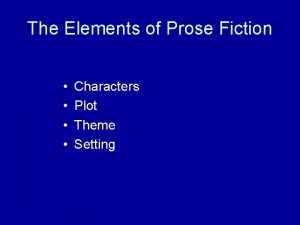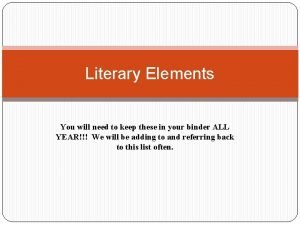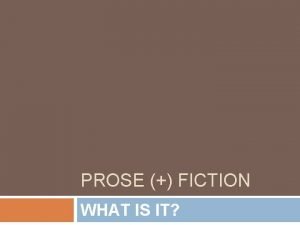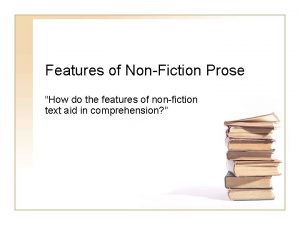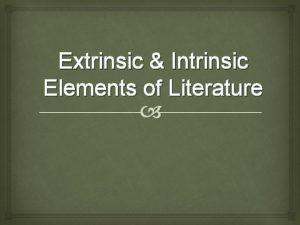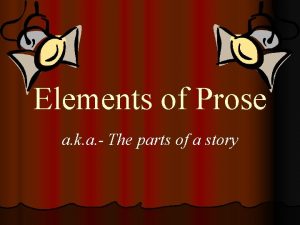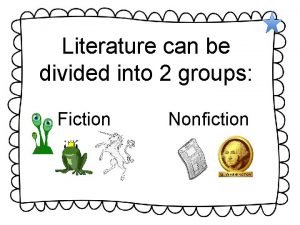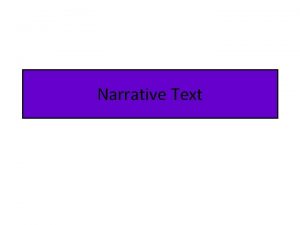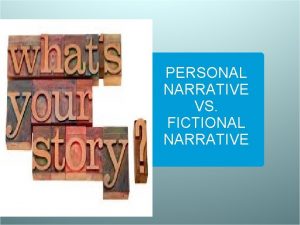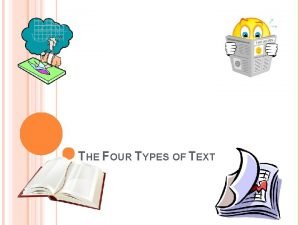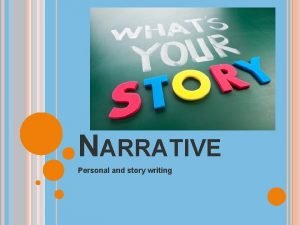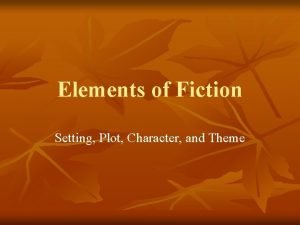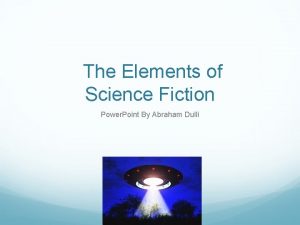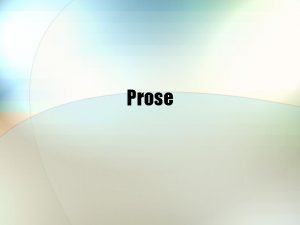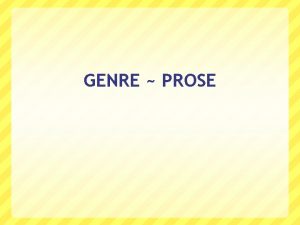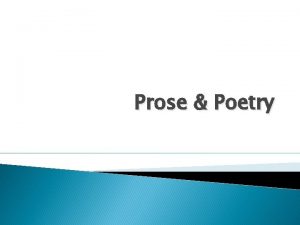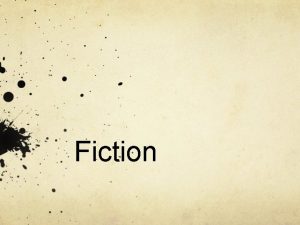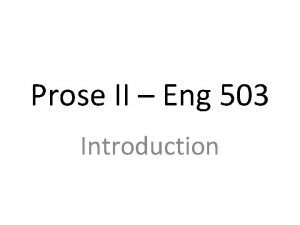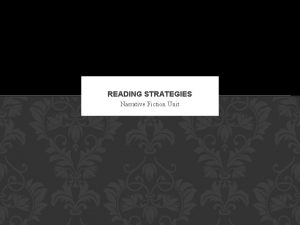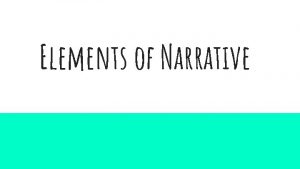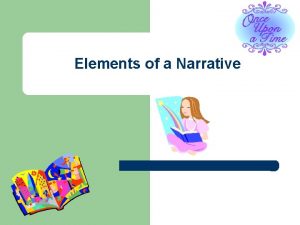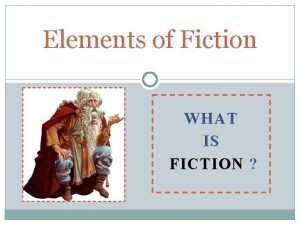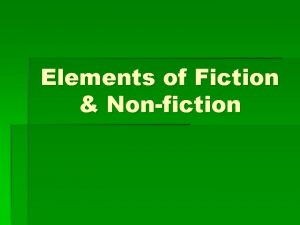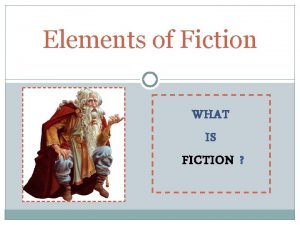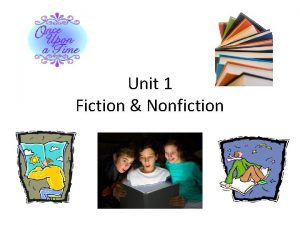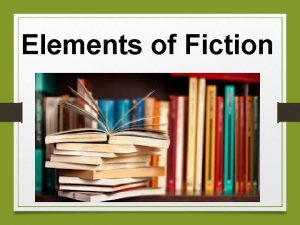Elements of Fiction Fiction is a narrative prose


















- Slides: 18

Elements of Fiction

Fiction is a narrative prose that shows an imaginative recreation and reconstruction of life and presents human life in two levels – the world objective reality made up of human actions and experiences, and the world of subjective reality dealing with human apprehension and comprehension.

Elements u Setting u Characters u Plot u Conflict u Point of View u Theme

Setting This is obviously where a story takes place. It is, therefore, the location. u It is also time of day, era or historical period, and atmosphere. u u Notice how for writers such as Edgar Allan Poe atmosphere is the most important aspect of plot. For a writer such as William Faulkner location and historical period are more important

Characterization u The characters in the story must possess three traits: they must be motivated, consistent, and believable. The author may reveal these traits in three ways: through description, through dialogue, and through characters' actions

Kinds of Characters u Fiction writers employ a variety of characters while weaving their tales. Beyond the standard definitions of protagonist (the main character in a literary work) and antagonist (the main character or force that opposes the protagonist in a literary work), recognizing the types of characters and the parts they play while reading an interesting story can add to the experience. In addition, a fuller understanding of the character types and their uses can increase a writer’s effectiveness in weaving his own fictional tales.

Kinds of Characters u Confidante- someone in whom the central character confides, thus revealing the main character’s personality, thoughts, and intentions. The confidante does not need to be a person. Example: In a story, Melvin Sanders is a detective on the trail of a serial killer. He travels with his pet dog, a pug named Chops. Instead of listening to the radio, Melvin talks to Chops, telling him his theories about the serial killer and his concern he may never discover the killer’s identity. In this example Chops is a confidante.

Kinds of Characters u Dynamic Character - a character which changes during the course of a story or novel. The change in outlook or character is permanent. Sometimes a dynamic character is called a developing character. Example: Ebenezer Scrooge, in A Christmas Carol by Dickens, was very stingy with his money. He worked his employees very hard for little pay. After his experiences with the ghosts that visited him, he changed his ways, paying his employees a more than fair wage, providing days off work and actually giving gifts. In this example Ebenezer Scrooge is a dynamic character.

Kinds of Characters u Flat Character - a character who reveals only one, maybe two, personality traits in a story or novel, and the trait(s) do not change. Example: In a story about a friendly teacher named Sandra Smith, Louis Drud is a janitor in her building. Louis is always tired and grumpy whenever Sandra runs across him and says hello. In this example Louis Drud is a flat character.

Kinds of Characters u Foil - a character that is used to enhance another character through contrast. Cinderella’s grace and beauty as opposed to her nasty, self-centered stepsisters is one clear illustration of a foil many may recall from childhood. Example: The main character in a story, a teenager named Sally, is a very honest person. She always tries to tell the truth and consider everyone’s feelings. The teacher assigns Betty to be Sally’s science lab partner. Betty enjoys gossip and likes to see people’s reactions, especially if it involves hurt or embarrassment. In this example Betty is a foil.

Kinds of Characters u Round Character - a well developed character who demonstrates varied and sometimes contradictory traits. Round characters are usually dynamic (change in some way over the course of a story). Example: A character in a story named Elaine never cuts anybody a break. She tells her friends and coworkers that charity and compassion have no place in society. On the other hand, Elaine can never pass up feeding a stray kitten or puppy, and always tries to find a good home for lost or abandoned pets. In this example Elaine is a round character.

Kinds of Characters u Static Character – a character that remains primarily the same throughout a story or novel. Events in the story do not alter a static character’s outlook, personality, motivation, perception, habits, etc. Example: Bert, a bumbling salesman, never takes the time to organize his files, properly record his sales, or follow up with customers. Finally, his boss gets fed up and fires him. Bert struggles for two months to find a new sales position. During that time, his car is repossessed for nonpayment and he maxes out his credit cards. Bert finally finds a new sales position but, before a week passes, he is called into a conference with his new boss. Bert is informed he must get organized or he’ll be fired. A week later the new boss fires Bert after he fails to follow up with an important customer. In this example Bert is a static character.

Kinds of Characters u Stock Character - a special kind of flat character who is instantly recognizable to most readers. Possible examples include the “ruthless businessman”, “shushing old librarian” or “dumb jock. ” They are not the focus nor developed in the story. Example: The main character in a story, Bernard, is hired by a computer company. His secretary is a blonde named Gidget, who is cute but forgetful and never gets a joke. In this example Gidget is a stock character.

Characterization u Although the character types are listed separately, characters may be (and often are) a combination. A foil, for example, could also be a round, flat, or even a stock character. While most protagonists in novels are dynamic (change over the course of the novel) and round, they don’t have to be, especially if the novel is plot driven as opposed to character driven. It’s not unheard of for a short story to feature a static protagonist. u Some character types are, by definition, opposite and cannot be considered. For example, one cannot have a character that is both flat and round, or a character that is both static and dynamic. The terms are useful for understanding a character and his place within the story. But, in the end, it is not about how a character can be named and classified (except maybe within the confines of a literature course). As a writer, it’s all about understanding the characters as you create and bring life to them for the reader.

Narrative Manner or Point of View u Narrative manner indicates who is telling the story. Authors may choose to have an uninvolved narrator tell a story. In this case the speaker has the luxury of being omniscient or all knowing and can reveal the thoughts of any or all of the characters. The second point of view is through a minor character. This voice can only report events and comment on them; it cannot know the thoughts of other characters. The third is the main character. Since the main character can reveal only his or her own thoughts the point of view is called limited omniscient.

Plot u This is simply what happens in a story. It is not everything that could happen, only what the author wants the reader to know.

Conflict u To discover theme, look for the central conflict of the story. Conflict can be internal (character versus self), or external (character versus a larger force such as nature or society or character versus another character). Most stories will contain both internal and external conflicts.

Theme v This is the underlying understanding of the intent of the whole story. v Theme is what the story is about, not what happens in the story. v Theme should not be confused with a moral. Short stories are not designed to offer pat answers; they are more likely to leave the reader with questions than answers.
 Unsur intrinsik prosa
Unsur intrinsik prosa The elements of prose
The elements of prose What is narrative prose
What is narrative prose Characteristics of nonfiction
Characteristics of nonfiction Prose fiction
Prose fiction Definition of prose
Definition of prose Coutryle
Coutryle Prose fiction
Prose fiction Intrinsic and extrinsic elements of literature
Intrinsic and extrinsic elements of literature Parts of prose
Parts of prose Science fiction
Science fiction Contemporary realistic fiction vs historical fiction
Contemporary realistic fiction vs historical fiction Fiction
Fiction What is the purpose of narrative text type?
What is the purpose of narrative text type? Fictional narrative
Fictional narrative Narrative text type
Narrative text type Personal narrative vs fictional narrative
Personal narrative vs fictional narrative Setting plot theme
Setting plot theme Elements of science fiction
Elements of science fiction

